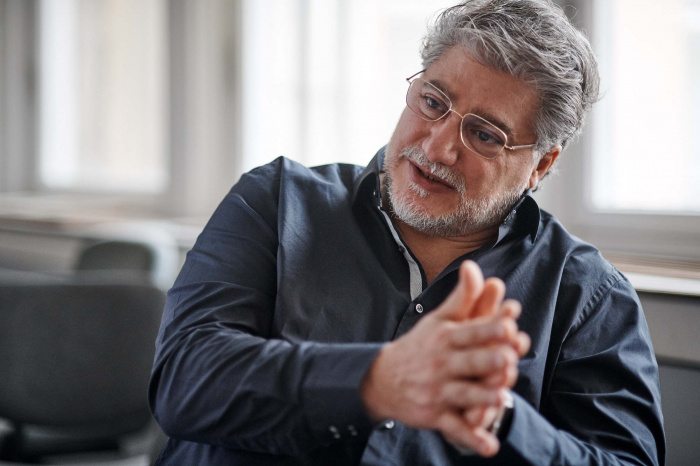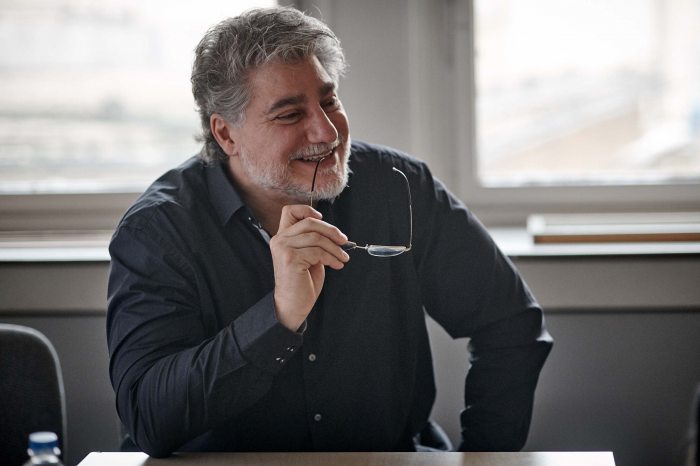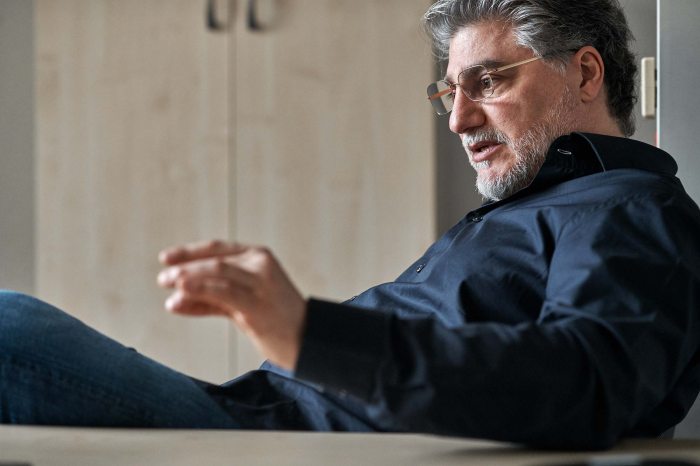„I share the hopes and concerns regarding migration” – Exclusive interview with composer José Cura
José Cura composer-conductor-tenor's first own opera will be performed at the Liszt Ferenc Academy of Music in Budapest. The „Montezuma and the Red Priest – A Comic Opera (But Not So Much)”, as its title suggests, serves not only to evoke laughter, but also raises issues as serious as the fight for equal opportunity. The Argentinian-born artist himself went on a difficult path to becoming a European citizen.

Photo by Tamás Páczai
– Why did you choose Hungary as the venue for the world premiere of this piece?
– We have been working together with the Hungarian Radio Art Groups (Since the 2019/2020 season, Mr. Cura will be for three years the permanent guest artist of the HRAG- Ed.), who are my artistic family, so whenever I'm preparing for a premiere, first I ask them for their opinion. My idea had immediately found their approval, so we staged the Montezuma together.
– How do you find working with the musicians of the Hungarian Radio Symphony Orchestra and the Choir?
– Working with Hungarians is captivating, I could best describe it with the words „dangerous” and „fiery”. They are rather temperamental, which I truly like about them. Apart from their work in the band, they also have other side jobs, such as teaching, so they are quite busy and there are times they are tired by the time they get here for rehearsals, so I need to keep that in mind. This is our second collaboration therefore I am getting to know them more: I already know who is married, who has children, who has any personal problem… I turn to them not as maestro but as a friend, which I consider essential in a community.
– How did you choose the musicians for the roles?
– It wasn't my job, as the artistic manager of the band was responsible for it. I knew the majority of them from earlier, we had been working together two months ago when we were preparing for the first rehearsals of the play. Because of the versatility of the characters, it was challenging to find the right people, for example the real Vivaldi was not only a composer but also a violinist, so playing his character required a tenor who plays the instrument. We are incredibly lucky with Donát Varga, who is a great violinist and tenor in one person.
– The story begins with a Mexican baron, the Lordship, who is traveling to Venice, where during the carnival, wearing the costume of Montezuma, the Aztec ruler he meets Vivaldi, who, inspired by the encounter writes an opera about the Indian king. What artistic tools do you use to take back the audience to the 1700-s?
– The language of the opera follows the aesthetics of the Baroque: a band of only forty people play the music on stage, consequently the lyrics is more audible. In contrast, during the time of romance, the entire band played during recitativo or dialogues, occasionally interrupting the continuity of the play with its monumentality.
Baroque, by the way, is my favourite era in music history and I am a great fan of Bach, for me he is the alpha and omega of music, but Vivaldi, Händel and Scarlatti are also close to my heart.
– To create a more realistic show, the characters speak their native language. Do you speak the actors' dialect?
– More or less, yes, I do. My mother tongue is Spanish, and I also speak English. I lived in Verona for four years and while I don’t speak the Naples dialect yet, I did learn the Venetian one. Of course, during the performance the audience will have the benefit of subtitles so they will understand all the words of the actors.
– You wrote Montezuma based on Alejo Carpentier 's novel „Baroque Music”, which you first read 30 years ago. Why did you wait for so long for the work to be staged?
– Even then I had found the book a great literary work, saw that it can potentially be remade, however I was only 27 and had no idea where to start. When it came into my hands much later, it has all become clear to me, thanks to my experience over the past decades. The key characters of the story are composers, so it was logical to turn it into an opera, not to say a movie.
– Despite his comic opera genre, Montezuma begins with a tragedy: Francesquillo, a servant of the Lordship, dies in plague. In a later scene, Vivaldi, Händel, and Scarlatti talk in a cemetery where they leave to bid the then deceased Wagner a farewell. How do death and comics fit together?
– You can die with humour. (laughs) If death is seen as a sorrowful event, it has nothing to do in a comic opera, however, instead of as a romantic element, I see it as part of the development, a transformation. Francesquillo's death is a symbol of the metamorphosis of a little child: the act begins with a young boy and ends with Philomeno, a man older than him, when the servant is reborn in his soul. Later, Philomeno takes control of the moral of the story, and Francesquillo had to die before he could enter the scene
– In the sixth scene, the Lordship challenges Vivaldi and questions his opera as historically unreliable, but the composer proclaims the primacy of the poetic illusion instead of stating the facts. Which do you consider more important in art?
– I believe in a happy medium: to allow room for imagination without distorting reality.
Personally, I love realism onstage, but the situation was different with this opera, as the novel it was based on was written in the genre of magical realism that is typical of Latin American literature. Carpentier toyed with the idea of what it would have been like if Vivaldi was writing in the modern era, parodying the fashion of the Baroque era, therefore women are singing many of the songs.
– Did you use other sources for the libretto?
– Carpentier does not elaborate on who Montezuma was because of space limitations, so I read historical texts and chronicles of the Aztec ruler, such as works of Bernal Díaz del Castillo and Fray Francisco de Aguilar, but these are only theories and do not reveal the whole truth. I built the most dramatic approach into the story. When one writes a play, they need different characters on stage. Instead of these disputed texts, I relied on paintings and my imagination to create the personal profiles of the characters. Looking at the pictures, I tried to figure out who they were. On that basis I imagined the plump Handel being a sweet, lovable figure, while the elegant and sophisticated appearance of Vivaldi I reckon, hid a captivating personality.
– Who's your favourite character?
– The servant of the Lordship, Philomeno who joins and follows him after Francisquillo's death and for him he is like Pinocchio's little counsellor: keeps watching and commenting on everything. Although musically he is not, but from a moral point of view he is the main character of the play: the way the story unfolds is in his hands.
Due to Philomeno being a person of colour, the issue of human rights has been raised several times in the opera, which is why the title of the play became „comedy – but not so much”.
– The story ends with the Lordship's decision to travel back to Mexico and release Philomeno, who is trying his fortune in France. Can he, a black man thrive there as a famous trumpet player?
– The servant is going to Paris hoping he will be called Monsieur Philomeno there and will not be called „the Negro”. When he hears his desire, the Lordship defies that this may change one day, to which Philomeno replies, „If you say so...” This leaves the question open, and it is not for me to answer it, the audience must draw their own conclusion. I do not think it is a great idea for the author to explain the ending, thus just letting the viewers go home, drink a coffee and forget what they have seen. It's more exciting if they must figure it out for themselves: in this case, they think about it for a long time and start conversations about how everyone interpreted the play.
– How do you see the issue of human rights?
– Racism is still present today, and the problem of migration is causing much debate in Hungary and throughout Europe. Politicians, to divide society, always paint a black and white picture, but this is a much more complex issue. I have nothing to say about it, I know both sides of the coin: my grandparents were immigrants from Italy, Spain and Lebanon. They arrived in Argentina at the beginning of the last century, and I was born there. Thirty years ago, I came to Europe. Migration between continents is a natural cycle: we start from one point to another therefore we cannot tell where we will be in a hundred years.
I sympathize with the situation of those on the road to a better life, but I also understand the concerns of Europeans, who are frightened by the masses of people coming to their country.
Uncontrolled admission of immigrants does not benefit anyone. We need to provide them a future, a job, give them hope and dignity, as begging for change on the street is not dignified but an open attack on migration. The only thing I cannot tolerate is the lack of education and compassion; with violence, neither side achieves its purpose.
– How do you remember the time you came to Europe?
– In 1991, I often waited at the police, in the company of Africans, to acquire a residence permit for three months and then came back every three months to apply for a new one. It took me over 15 years to establish my livelihood here, including obtaining a European passport. These experiences also influenced my career: I wanted to travel to England before the Schengen Convention existed, and there were problems with my Argentinian passport. When I wanted to return to Italy, the police officers treated me rather rudely at the border. I know what it is like when immigrants have no money to eat and can't find work. I remember once someone left me on the roadside because he was convinced that every Argentinian is a thief. Over the past 57 years of my life, I have had many dramatic and many beautiful moments, and those experiences have made me the man I have become.
– How important is the South American culture to your life?
– Every culture is important if you want to be a great artist. It is, of course, impossible to make it all our own, but we must strive to at least discover the cultures that surround us or represented by our characters. Due to my background I can relate to the Spanish and the Italian, but also the Arabic and the Lebanese.
– What is your relationship to the Hungarian culture?
– Although I have been visiting Hungary for twenty years, during my visits I spend little time here and have no opportunity to sightsee. Right now, I'm commuting between the Academy of Music and the Radio, so while the National Museum is within a stone’s throw, we work 10 hours a day, so by the time we finish, it closes. In a few months however, I may be able to give a different answer to the question. For the first time, as a guest artist at HRAG, I have a closer working relationship with the nation, so I slowly absorb the Hungarian culture and lifestyle and they don’t see me as a guest anymore
– The audience will first see the fruits of your joint work on January 29th. What kind of reception do you expect?
– I can't tell you that, but I trust they will like it. If they will not boo, that's already positive feedback. (laughs)
– Who is the target audience for your comic opera?
– This is a remarkably clever and dangerous question! (laughs) Montezuma is for a wide audience. This is an intellectual comic opera that contains many references to other works. Viewers will have fun even if they have no prior knowledge of them, but the play will be enjoyable best if they recognize all the hints. This is no different with other forms of art. If you're going to the Louvre not having heard of the Mona Lisa, you are only going to see a smiling lady in front of you, but if anyone explains the hidden meaning of that masterpiece, all the colours, the use of the brush, the thoughtfulness of the picture will make sense at once. Being knowledgeable thus allows us to have more fun.
– What references did you hide in the opera?
– In his book Carpentier cites many musical works as he was also a music historian. In addition to the works of Vivaldi, Handel and Scarlatti, in the Montezuma we will evoke the Othello from Verdi, the Circus Polka from Igor Stravinsky and for twenty seconds a few lines from a literary creation, Shakespeare's Romeo and Juliet will be quoted. We also refer to Walt Disney as a joke, juxtaposing his tales with Wagner's fantastic world.
– Montezuma is your first opera. Why has composing previously been neglected in your career?
– As a tenor, I have given a hundred performances a year, with no time left to compose. Composition is a whole-person task; when I orchestrated the music of Montezuma, I spent weeks in the studio, talking to no one, and the outside world ceased to exist for me.
– Do you plan on composing more pieces anytime soon?
– I'm looking for another libretto, and I hope it won't take another thirty years before I find it, that would be too late. (laughs) Composing music is not the greatest challenge today. It’s finding the perfect libretto that interests people.
(Translated by János Farkas)









